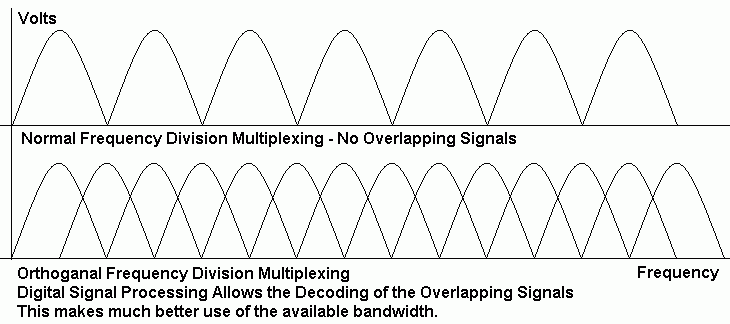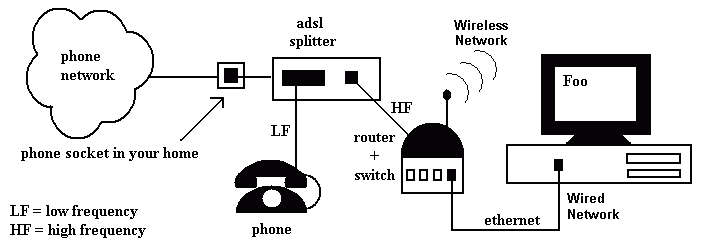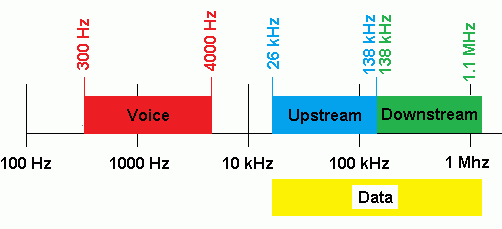

Multiplexing - Frequency Division |
|
To gain access to revision questions, please sign up and log in.
Each carrier is modulated with digital data. Using many carriers with error correction techniques improves the reliability of the communication link. If a few of the carriers get damaged, the link still works.

Asymmetric Digital Subscriber Line (ADSL) uses a simple form of Frequency Division Multiplexing. Voice / phone call data arrives at frequencies between 300 Hz and 4000 Hz. Computer data arrives at a much higher frequency. Line splitters (filters) are used to separate these two signals. The low frequencies go to phone handsets. The high frequencies go to the ADSL router or modem. These are nice examples of low and high pass filters.


This diagram shows the audio, the upstream and the downstream spectra. All three look as if they have the same bandwidth but notice the logarithmic graph scale. In fact the downstream spectrum is about ten times the upstream bandwidth. Both are many times the audio bandwidth.
Here is a zoomed in view showing many overlapping channels each occupying about 4.3 kHz. This is called Orthogonal Frequency Division Multiplexing (OFDM) and Digital Signal Processing (DSP) is able to extract the data from the overlapping spectra.

The ADSL computer data is sent using many carriers. Each carrier is modulated with digital data. The higher frequency carriers suffer more from attenuation (signal loss). If the distance to the exchange is too great, the highest frequencies become unusable. This is why connection speeds get worse as the distance to the exchange increases. The ADSL router automatically negotiates with the exchange to decide on the highest usable frequency.
ADSL and most other digital signals transmitted using Frequency Division Multiplexing are decoded using a mathematical technique called "Fast Fourier Transforms (FFT)" using DSP (Digital Signal Processing) chips.
The signal is sampled at regular TIME intervals at more than twice the highest FREQUENCY. This is called the TIME domain. Then the FFT analysis transforms the data into the FREQUENCY domain. This allows the many carriers to be separated out and the data they are carrying can be recovered.
Here is a cartoon which completely fails to explain the technique. Thank you xkcd.
[Elizabeth Basha] wrote this paper on the use of Field Programmable Gate Arrays for Fast Fourier Transforms.
reviseOmatic V3 Contacts, ©, Cookies, Data Protection and Disclaimers Hosted at linode.com, London